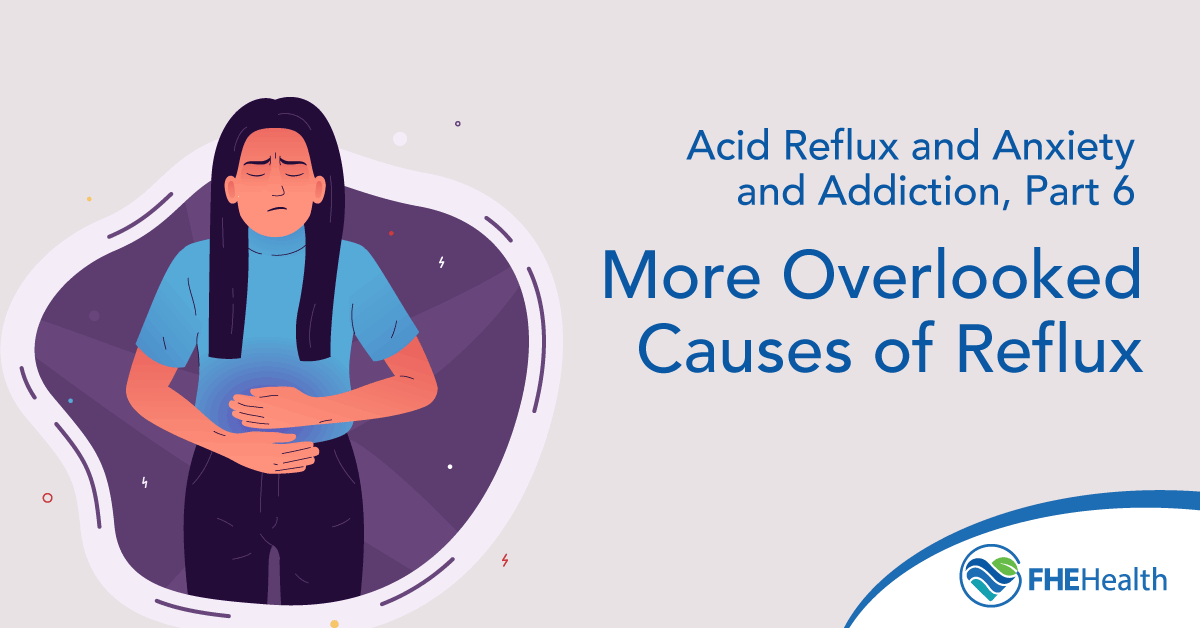
In Part 6 of this series, you will notice a similar prevailing theme: Once again, too much stomach acid has nothing to do with the underlying cause of reflux. Sometimes acid goes into the esophagus, but it isn’t because there is too much acid. The real root cause is relaxing the guard gate between the stomach and the esophagus (the lower esophageal sphincter [LES]).
This post will discuss four additional causes of reflux: obesity, hiatal hernia, laryngopharyngeal reflux (LPR), and histamine intolerance. We will also discuss exercises that anyone can do that might help with reflux due to many underlying causes.
Obesity and GERD
Research shows that excess weight can cause reflux and that weight loss can improve and even reverse acid reflux (1-3). Interestingly, when people gain weight, even when their BMI is considered normal, there is an increase in GERD with weight gain (3). This is thought to be due to excess weight putting pressure on the stomach, leading to the relaxation of the LES. However, in some cases, the excess pressure leads to a hiatal hernia.
Hiatal Hernia
Obese individuals are over three times more likely to have a hiatal hernia compared to those who are not obese (4). This is a structural issue that will cause reflux symptoms. This is where part of your stomach is pushed up through the diaphragm. This can weaken or displace the lower esophageal sphincter (LES).
Remember, the LES is the guard gate that keeps stomach contents from returning to the esophagus. Weight loss is often very effective in reversing hiatal hernias and is usually recommended for individuals with this condition. Doctors will still give standard reflux medication to help relieve symptoms.
What else can you do if you have a hiatal hernia?
First, not everyone with a hiatal hernia is overweight. Therefore, it is essential to consider other options to address this structural issue.
Research has shown that there are specific techniques for manual manipulation, often done by trained osteopathic doctors or chiropractors, which can effectively push down the hiatal hernia (5-7). For those who do not have access to a healthcare provider trained in these techniques, you can try different exercises daily that might also be effective in reversing a hiatal hernia:
- One exercise, “the bridge swallowing exercise,” effectively strengthens muscles in this area and improves reflux (8).
- Diaphragmatic breathing has also been shown to improve reflux and strengthen muscles in the diaphragm (9).
While these two studies weren’t specifically for those with hiatal hernias, they may still be helpful since they strengthen the muscles involved in hiatal hernias. There is a product in Europe that has been studied in reversing GERD and hiatal hernias with a great success rate, called IQoro (10). However, it is not currently available in the United States. If you go onto YouTube and type in “exercises for hiatal hernia,” you will find many options. While most of these exercises haven’t been studied for effectiveness, they likely couldn’t hurt.
Exercises for GERD
Consider trying these evidence-based strategies to reverse your reflux:
Bridge Swallowing Exercise (8)
Do the following exercise on an empty stomach, twice daily, for 3-5 minutes.
1. Lie on your back with knees bent and feet on the floor.
2. Lift your hips into a bridge position.
3. While holding the position, perform 10 dry swallows (swallow without food or drink).
4. Hold for 2–3 minutes, then lower your hips.
Diaphragmatic Breathing (9)
Do this exercise for 10-15 minutes per session, twice daily. Consider doing once a day before a meal (in either position) and once a day, 30-60 minutes after your largest meal (while sitting upright).
1. Sit or lie down in a comfortable position and make sure your back is supported.
2. Place one hand on your chest and the other on your abdomen.
3. Inhale deeply through your nose, aiming to expand your abdomen (not your chest).
4. Hold for 1–2 seconds.
5. Exhale slowly through your mouth, allowing your belly to fall.
6. Each complete breath cycle should last ~10 seconds (4–5 seconds in, 4–5 seconds out).
LPR vs. GERD
Laryngopharyngeal reflux (LPR) is a form of reflux that goes higher up in the esophagus. While there can be an overlap in symptoms, the following symptoms are more common for LPR:
- Chronic throat clearing
- Persistent dry cough
- Hoarseness or voice changes
- Sensation of a lump in the throat
- Post-nasal drip or mucus in the throat
- Sore throat
- Difficulty swallowing or feeling like food is stuck
- A chronic feeling of needing to clear the throat
- Ear fullness or pain without infection
There are tests a Gastroenterologist can do to determine if your reflux is LPR versus GERD. While standard reflux medication (proton pump inhibitors [PPI]) is commonly given to people with LPR, it is often less effective (11). This is because LPR is usually partly or entirely caused by non-acid reflux, such as pepsin or bile reflux (11, 14).
One study showed that Alginates were more effective for LPR (12). This makes sense because instead of lowering acid, it works with the acid and forms a “raft” like barrier in the stomach that can trap pepsin and prevent acid and pepsin from refluxing into the esophagus. Gaviscon is the standard over-the-counter alginate product with unnecessary artificial additives. I prefer recommending Life Extensions Esophageal Guardian supplement (contains alginate and other supportive nutrients) and/or Pure Encapsulations DGL Plus.
LPR might be secondary to motility issues, as one study showed that slow motility led to reflux going higher up in the esophagus and being less acidic than traditional GERD (13), a similar pattern to LPR. See the post on motility and reflux for more information on addressing motility issues. If your gallbladder is removed, you have pain on your right side under your ribs (where the liver is) or have other liver or gallbladder conditions, LPR may be secondary to bile reflux (14). If that is the case, check out this earlier post on bile reflux to learn more about what you can do.
Histamine Intolerance and Reflux
You may notice that LPR has common symptoms, as those who struggle with allergies and other histamine-related issues. Currently, there is no evidence linking LPR and histamine. However, a case study was published where a patient with LPR was discovered to have histamine intolerance (15). Once put on a low-histamine diet, their reflux symptoms resolved. I have seen this in my practice as well. I have successfully cleared up reflux symptoms with patients who have apparent histamine intolerance with reflux by combining a low-histamine diet and supplements such as Professional Health Products, Histamine Scavenger, and ABP1 Assist Hista/Gut.
If you suspect you have histamine intolerance, you can test the diet independently and see if you notice any benefits. If you do, consider working with a knowledgeable healthcare provider since treatment can be nuanced.
What is a low-histamine diet?
The following is a list of foods known to raise histamine the most. Research is mixed as to which foods will raise histamine in the body, but these are the top foods avoided on a low-histamine diet:
- Bread: due to yeast content or fermentation through sourdough
- Animal protein that has been canned, smoked, aged, cultured, fermented, or cured: Tuna, shellfish, canned fish (anchovies, sardines, tuna, etc.), smoked fish, mahi-mahi, deli meat, aged or hard cheese, yogurt, bacon, sausage, canned meat, hot dogs, smoked/cured meat/fish, leftovers
- Seasonings: Consume, bullion, gravy mix, seasoning blends, something other than an herb or spice (i.e., yeast extract, monosodium glutamate), soups here contain consume, so avoid soup here.
- Salad toppings: tomatoes, salad dressings, vinegar (unless distilled white), dried fruit, aged cheese, and croutons.
- Fruits: strawberries, raspberries, lemon, lime, orange, and all other citrus, dried fruit, kiwi, pineapple, avocado, banana (if there are any brown spots on the skin), over-ripe fruit, dried fruit
- Vegetables: tomato, spinach, mushrooms
- Condiments: mayonnaise, mustard, ketchup, soy sauce, Asian sauce, vinegar, sour cream, artificial preservatives/dyes, pickles, olives
- Other: leftovers, yeast, coffee, caffeinated tea (especially black tea), chocolate.
Additional: Eggs are moderately high in histamine and might need to be avoided or limited.
Closing
Whether you have a structural issue, excess body weight, chronic histamine issues, pepsin, or bile reflux, there are solutions available for you to try. While PPIs can have some benefits, they don’t address the underlying problem and rarely give complete relief in these cases. If you are on a PPI and still experiencing symptoms, it is highly recommended to read this series and discuss with your doctor if further testing is needed. Once you have a diagnosis, you can use this blog post series to start a conversation with your healthcare provider to see if trying these more targeted approaches would suit you.
Next Post
Next, we will discuss diet for preventing reflux in the short and long term, and how food sensitivities may also cause reflux for some people.






